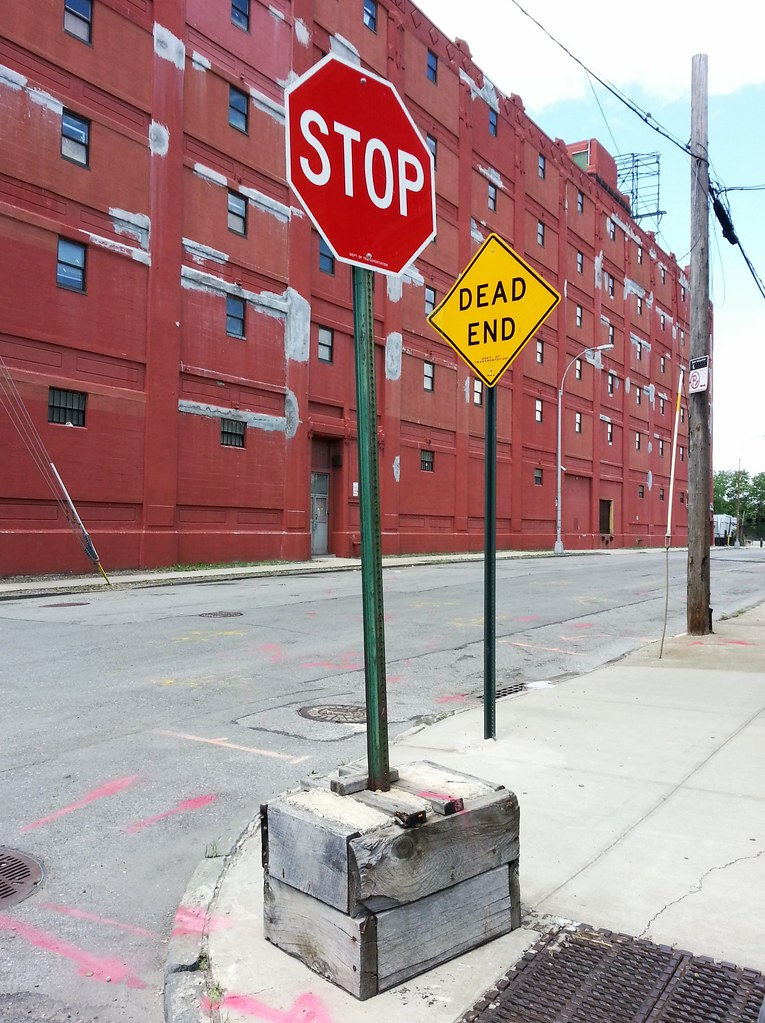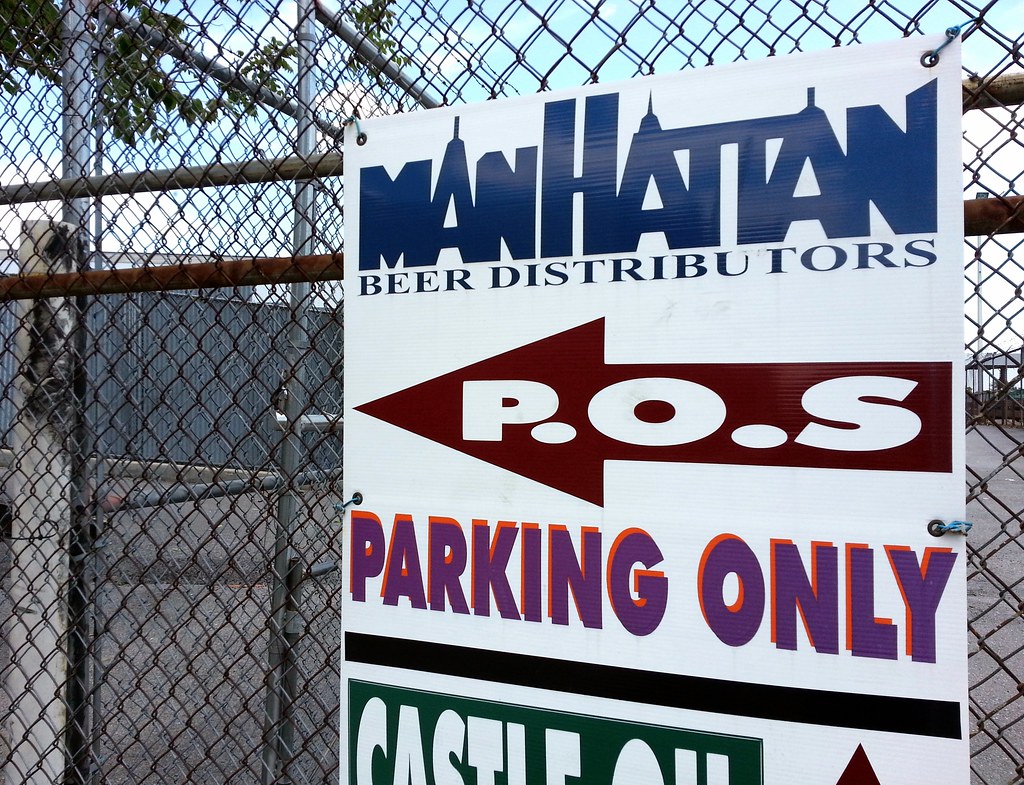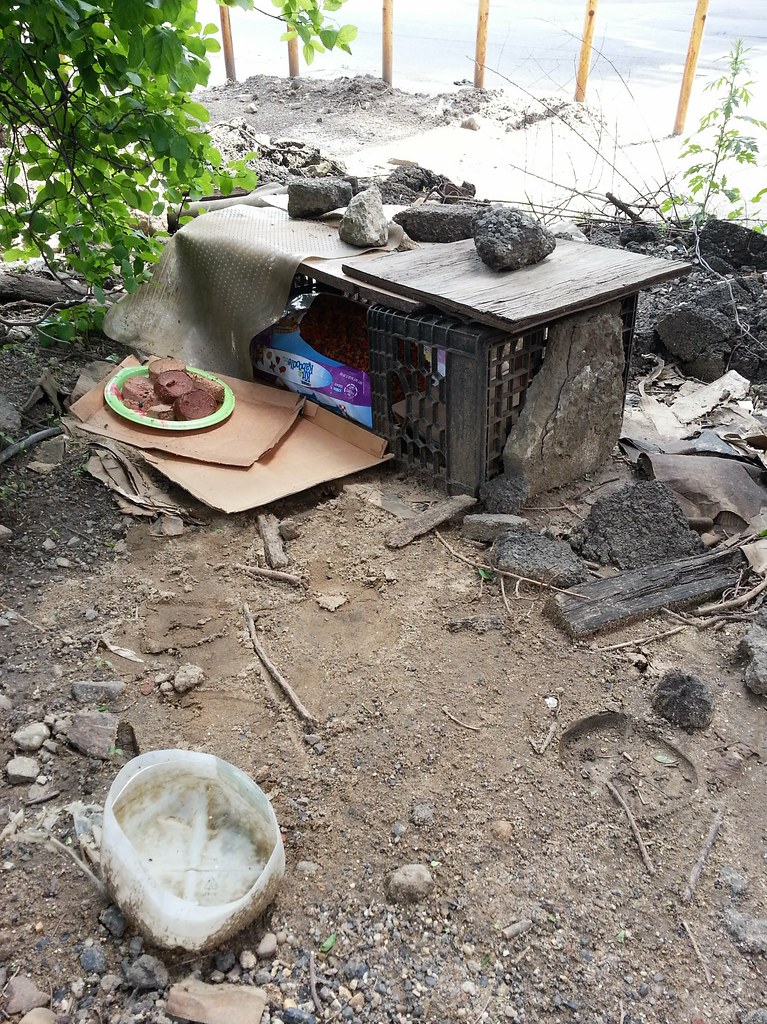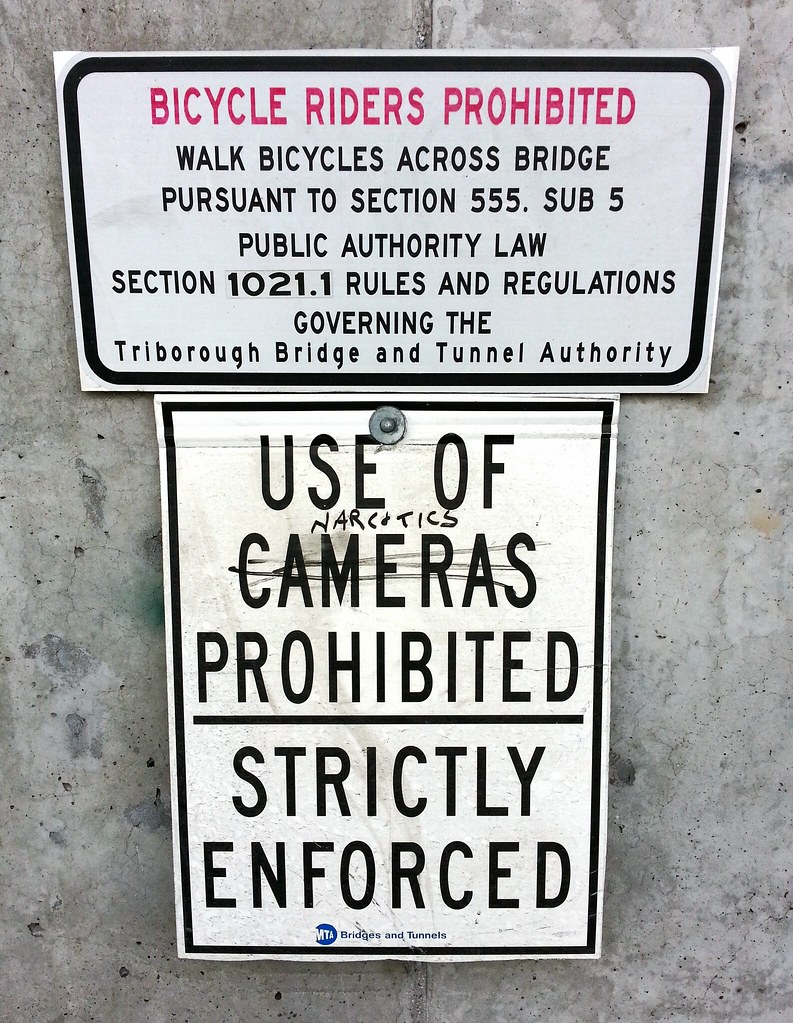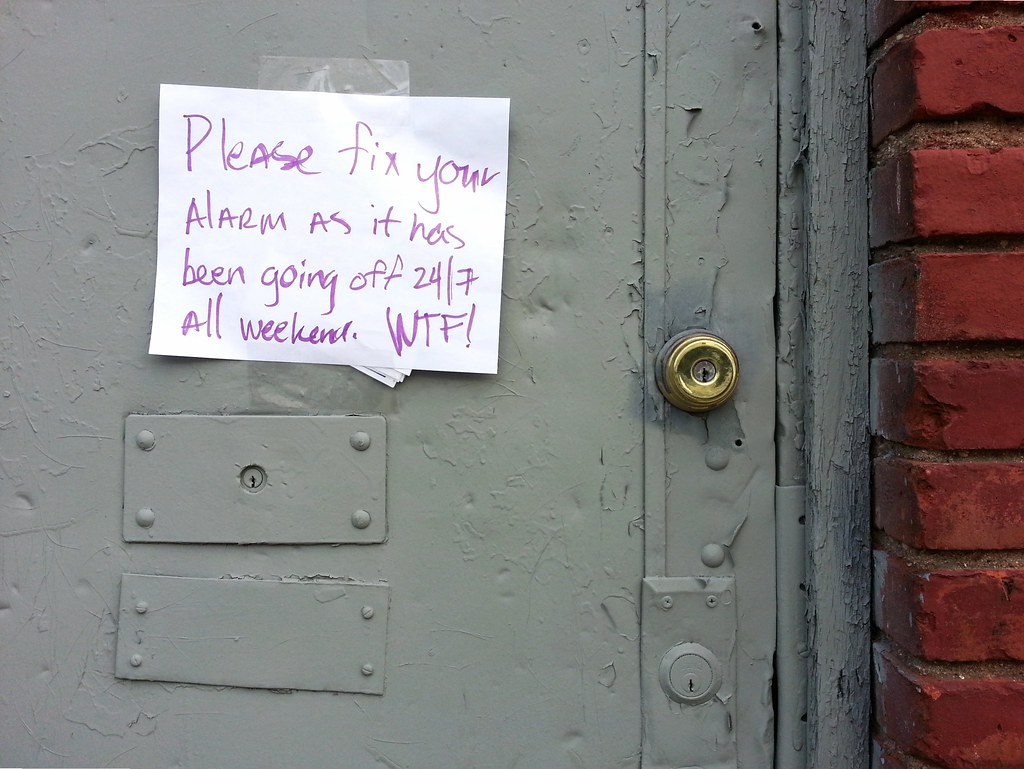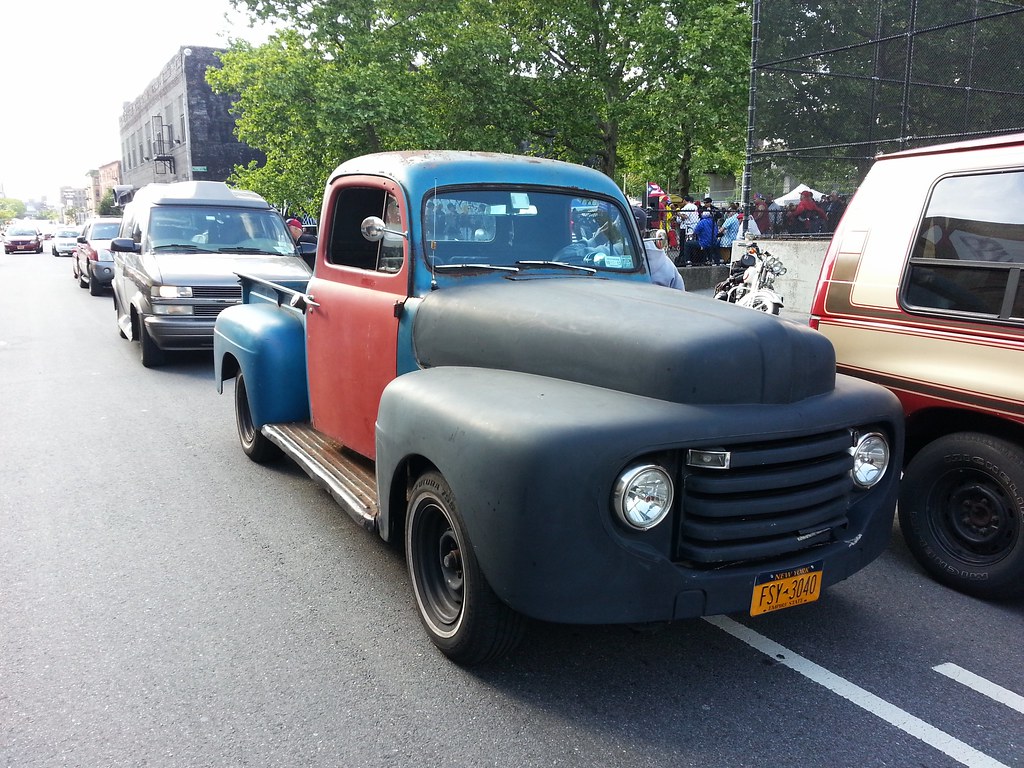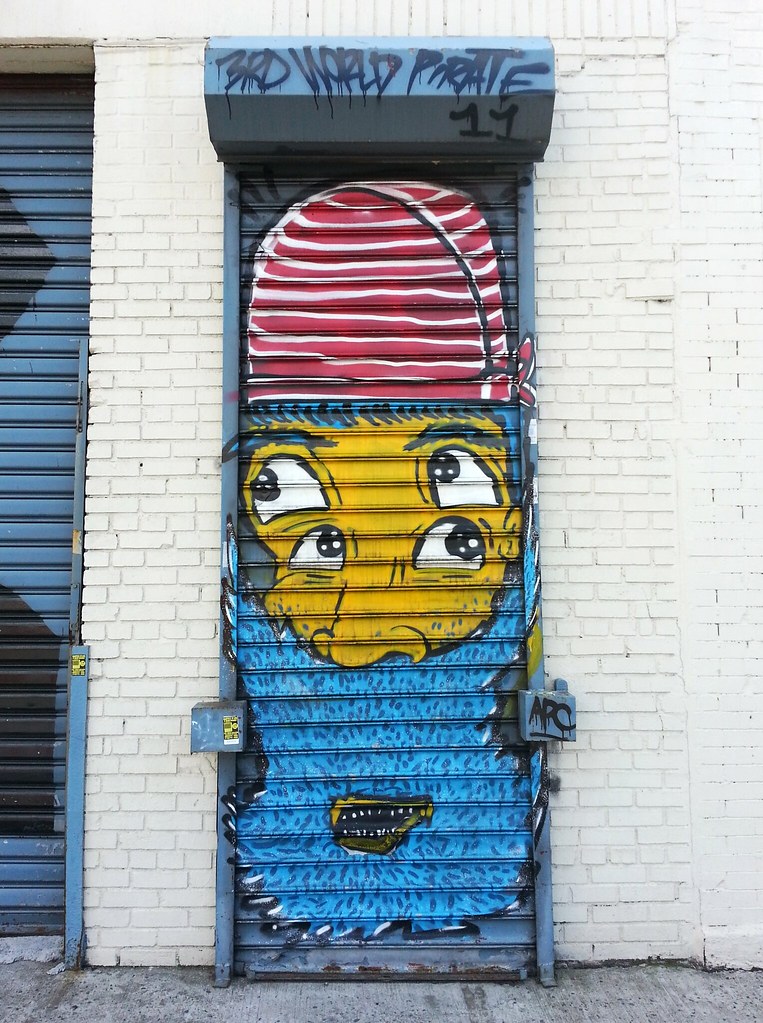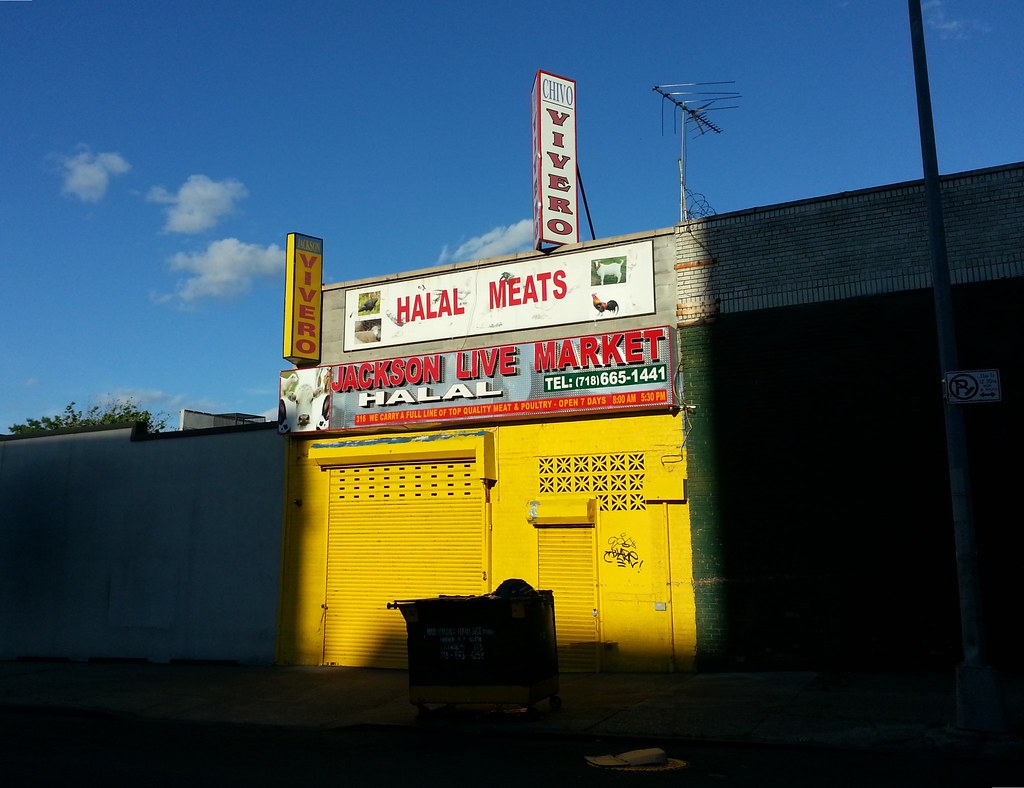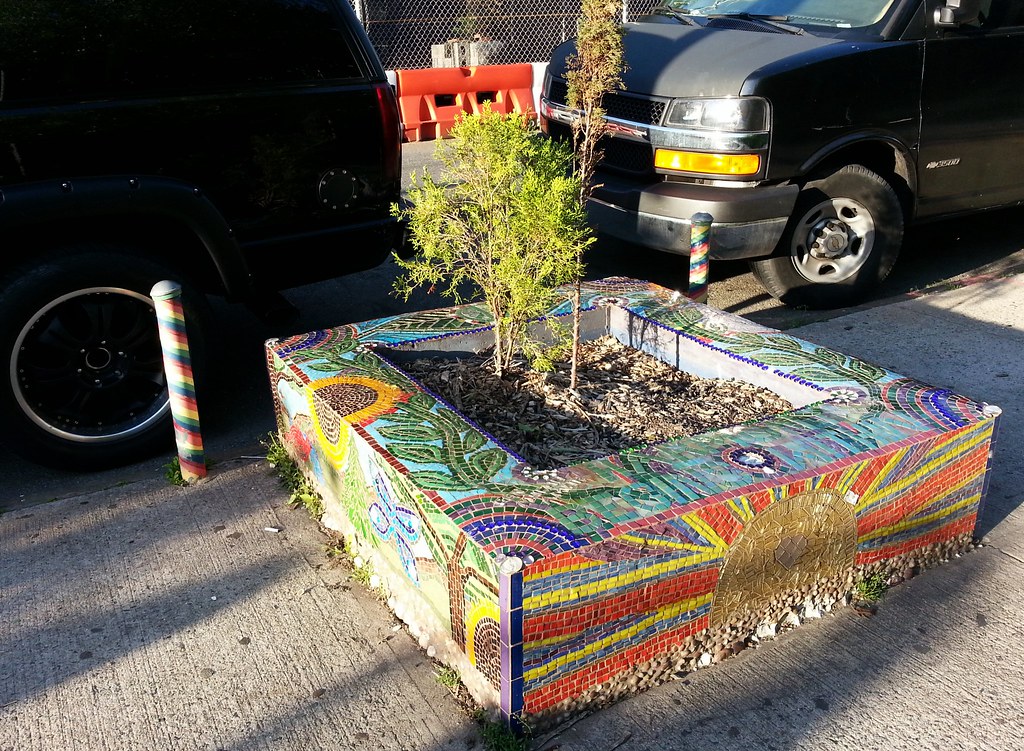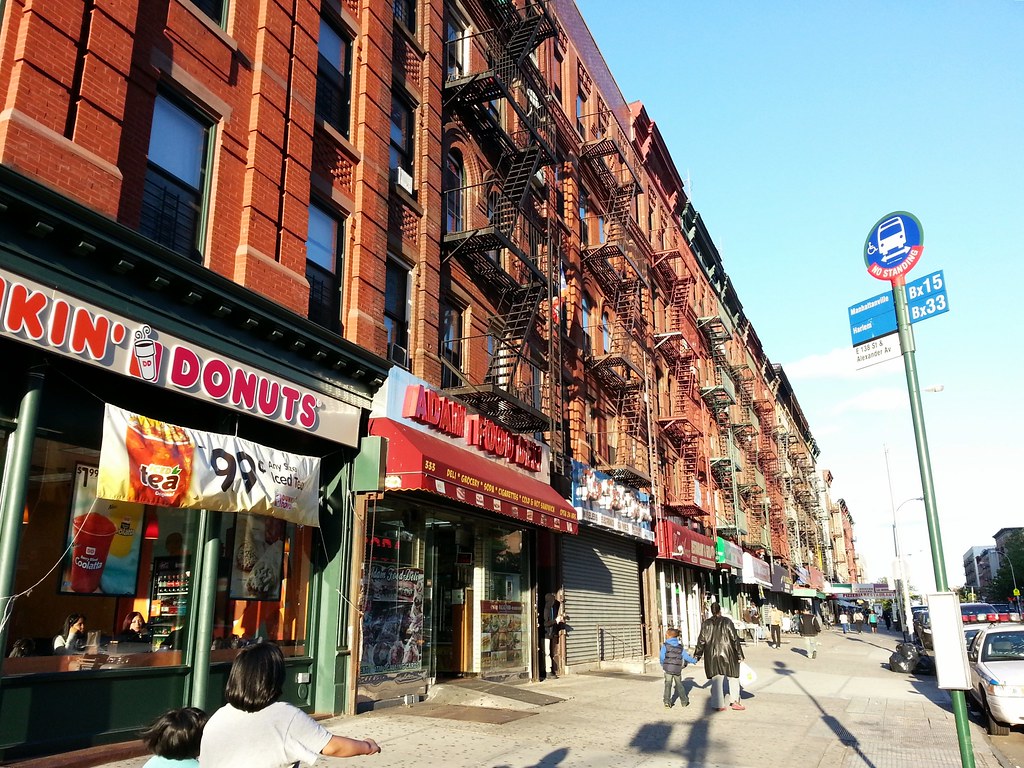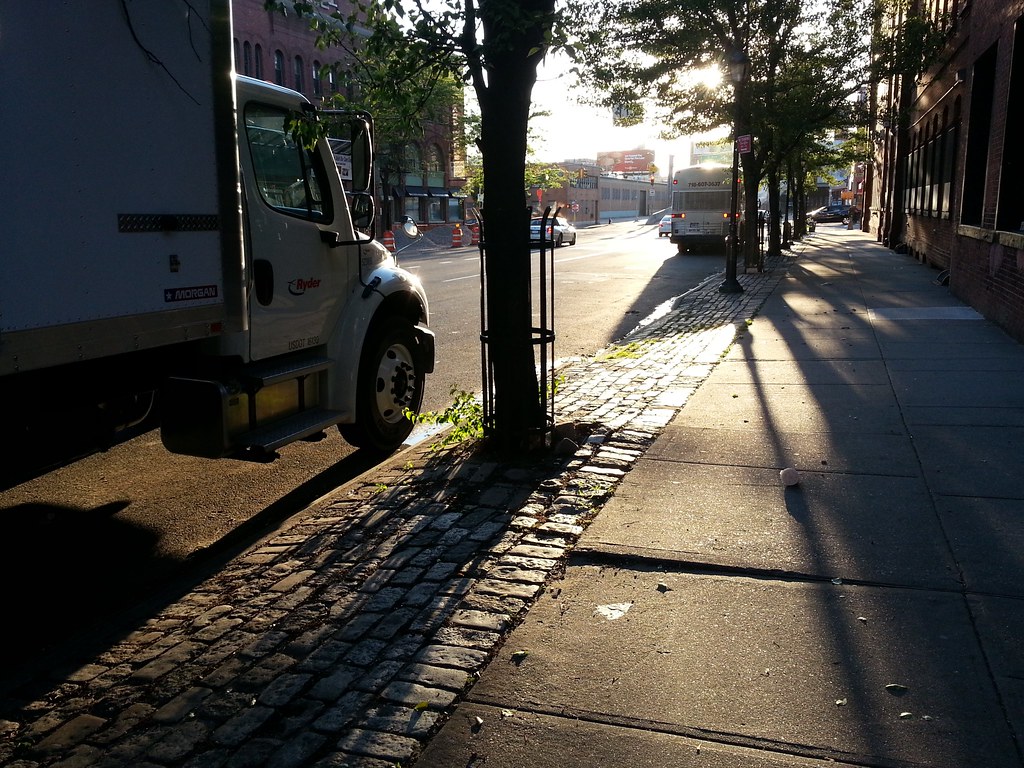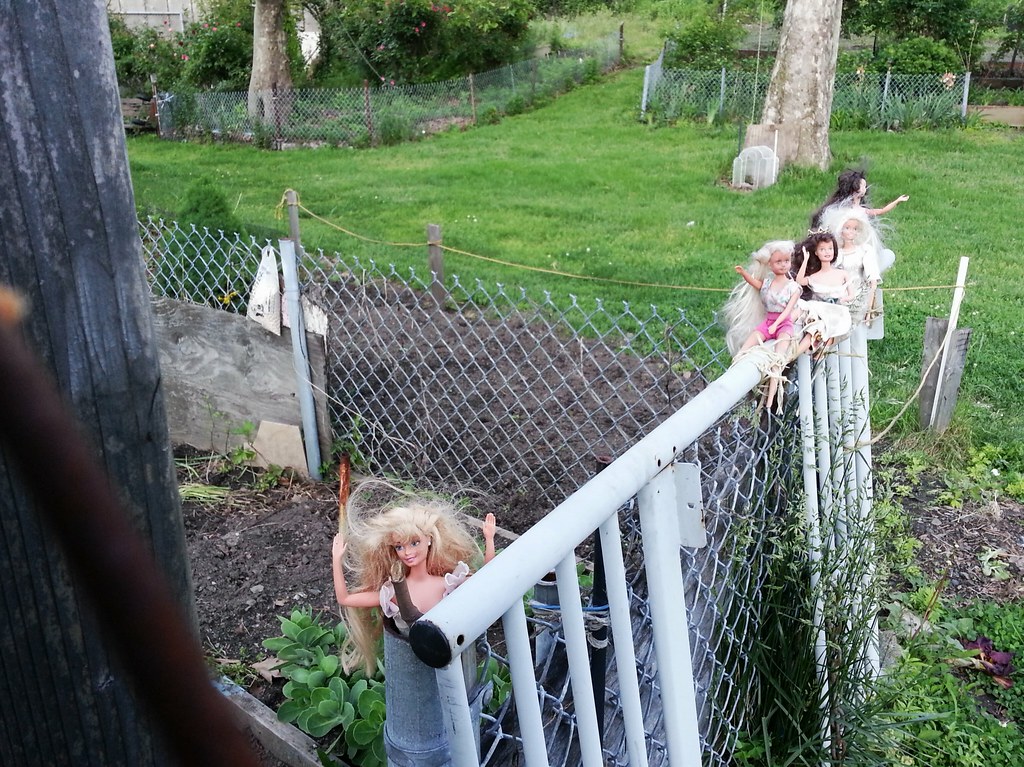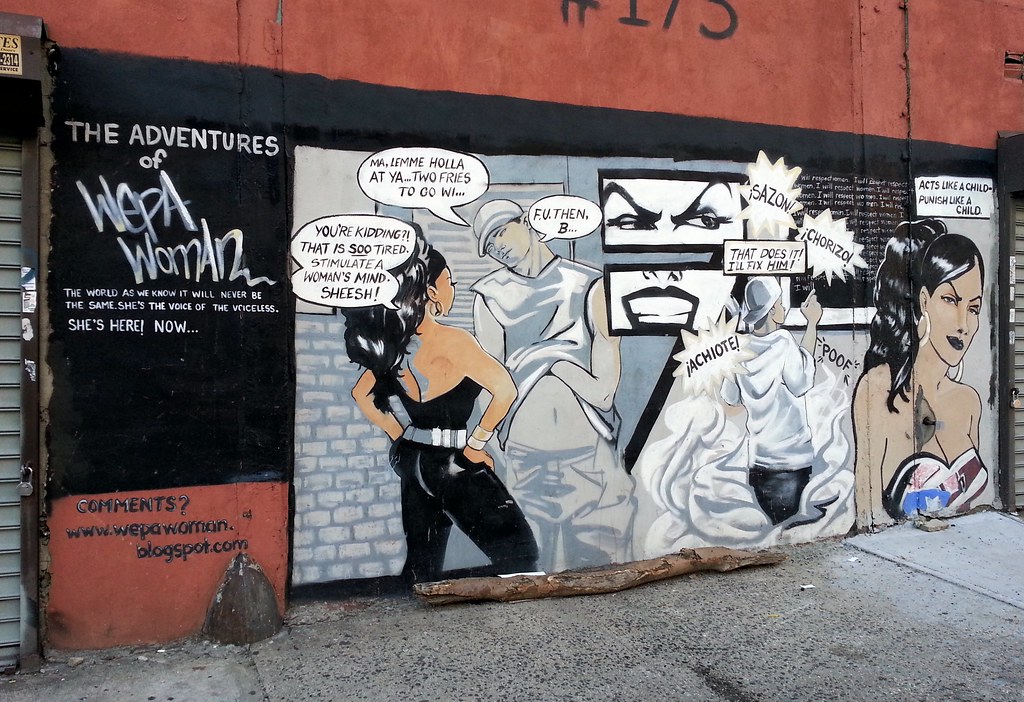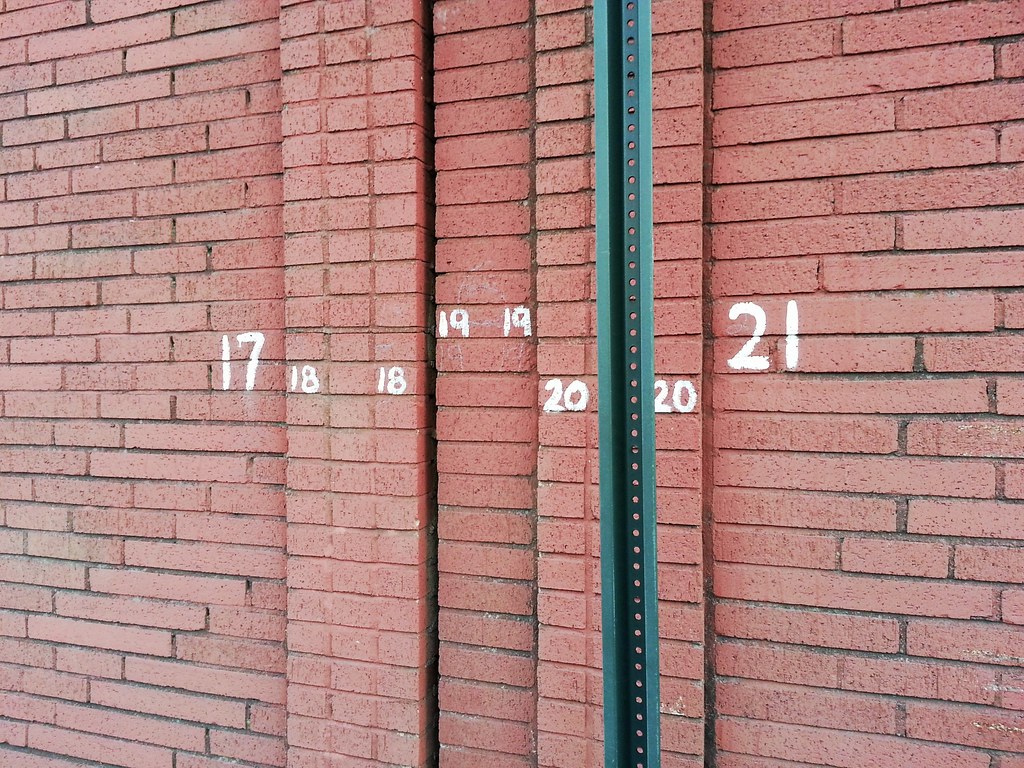
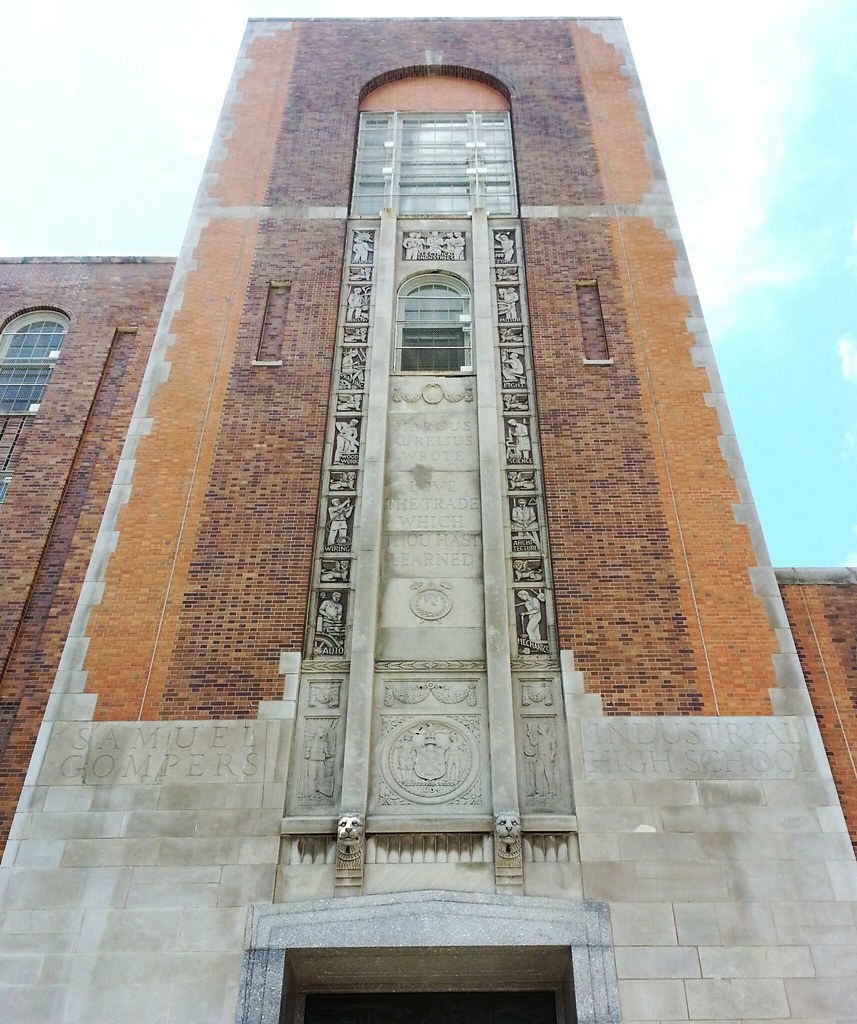
"Meant to look like a factory" and "purpose-built as an 'industrial' public high school, [Gompers] was the first such institution to focus its training on a single industry-the electrical, rather than on multiple trades, preparing students for the integrated labor of mass production. Its building appropriately represents a 'general electric' plant." Gompers had been struggling for a while when the city decided to close it last year and replace it with a couple of smaller schools operating in the same building.
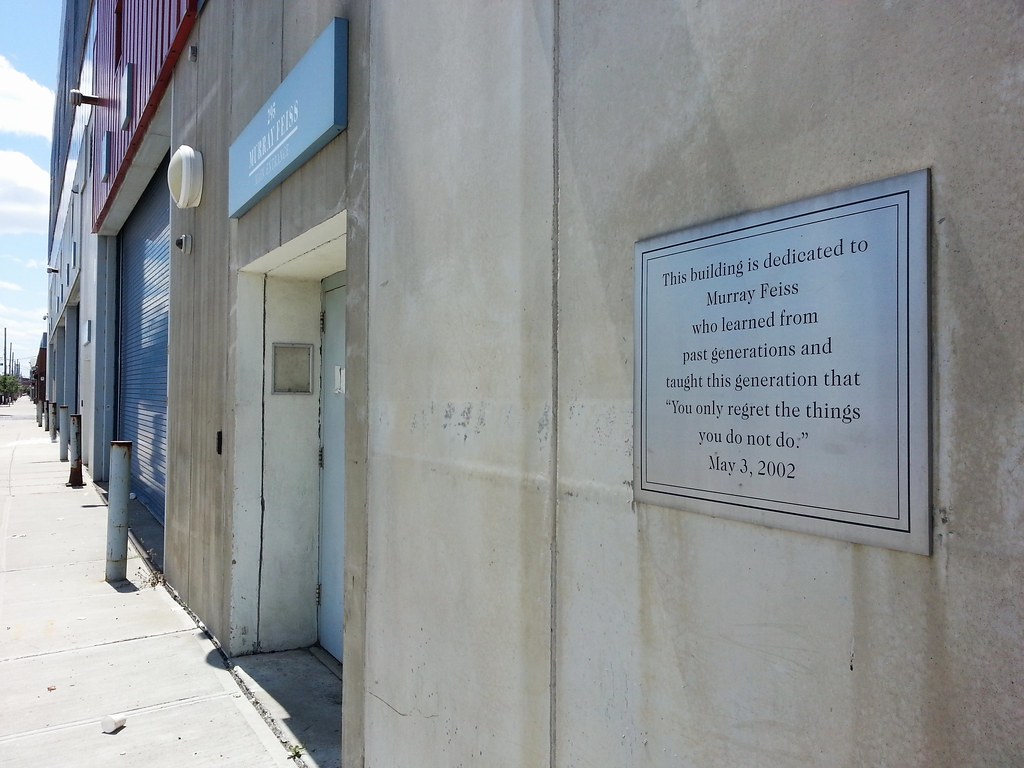
but I now know plenty about his late wife Dorothy, the "First Lady of Lighting".

Looking out into the East River from the old 134th Street ferry terminal in Port Morris, we can see the trees and smokestacks of North Brother Island. (The smaller South Brother Island is located just out of frame to the right.) Now a bird sanctuary, North Brother was formerly home to a quarantine hospital (where Typhoid Mary spent her last two decades), college dorms for veterans, and a drug rehab center, and was also where the burning General Slocum ran aground and sank in New York's worst pre-9/11 disaster. The island has been uninhabited (by humans) for the past 50 years; here are some photos of its many ruins.

For years, one of Richard Serra's massive curved steel sculptures (possibly Bellamy) was being stored, in its constituent parts, in the crane yard to the north of the old 134th Street ferry terminal, just behind the taller of the two squat brick buildings. On one of its more exciting days back in 2006, a group of artists snuck inside the piece and stuck a bunch of magnets to its walls. Mr. Serra's creation has now seemingly been relocated — perhaps finally delivered to its owner — but, as you can see, an intriguing new huge rusty metal thing (the wheel-like contraption standing behind the shorter brick building) has emerged to take its place.

Heading south from the Oak Point Yard, the elevated tracks continue over my head across the Bronx Kill toward the Hell Gate Bridge, while the tracks at my feet hook west toward the Harlem River Yard, where FreshDirect is controversially planning to set up shop. If the company does indeed relocate from its current home in Long Island City, is it going to take its extraordinarily obnoxious 5000-square-foot video billboard with it?

There are hundreds of these colorful fire-and-brimstone signs stabbed into the trees of the Bronx, but this is the first instance I've seen of one superimposed atop an older model.

Sidewalks run along both sides of the Triborough's Bronx Kill span; after crossing the narrow strait, the walkways dip below the bridge and merge, emptying foot and bike traffic onto Randall's Island.
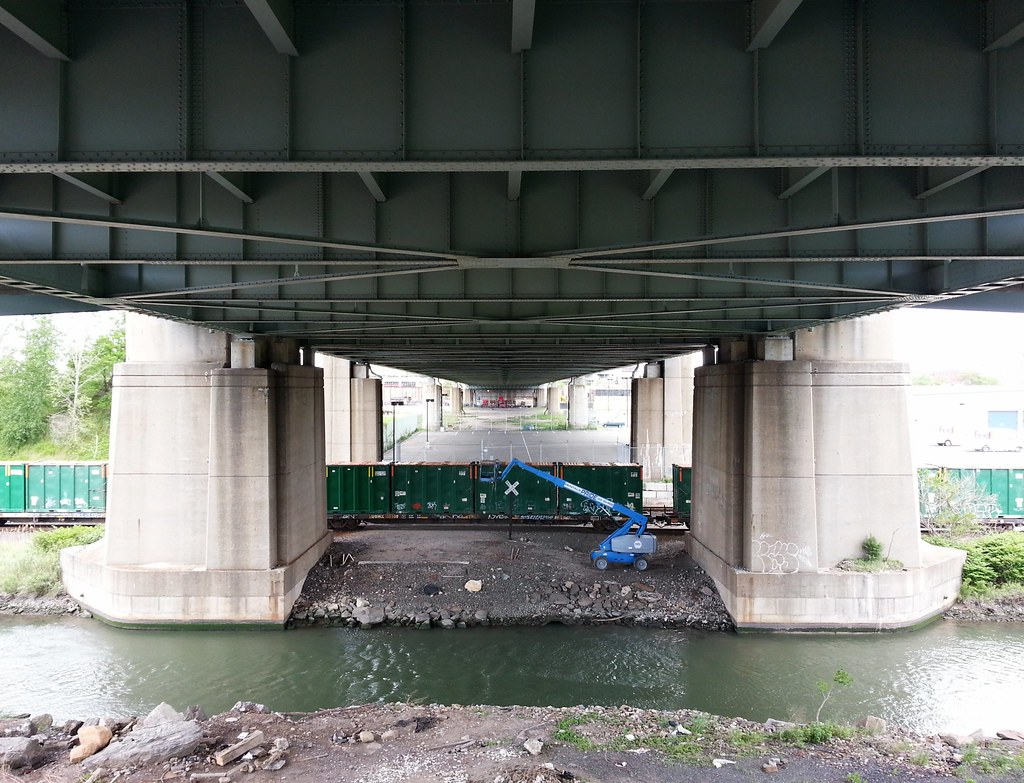
We're looking from Randall's Island (part of the borough of Manhattan) across the Bronx Kill into the Bronx.

For decades, Con Edison supplied electricity to Randall's Island through two sets of cables encased in concrete beams spanning the Bronx Kill beneath the railroad viaduct approach to the Hell Gate Bridge. Because the beams sat so close to the water, kayakers and canoers could only pass under them during a narrow window when the tide was just right.
A couple of years ago, the little red bridge you see above (and can see much more clearly here) was built to support the future Randall’s Island Connector, a multi-use path that will link the South Bronx to Randall's Island. (As you may have suspected, the bridge is not yet open to the public; it lacks a deck on which people can walk.) An array of new Con Ed conduits, partially visible above, is attached to the bottom of the bridge, clearing the high tide level by a few feet. To the relief of local boaters, the utility company finally got rid of its old concrete beams sometime in the last year or so, rendering the kill fully navigable for small recreational watercraft.

This little strait was once much wider, but was narrowed considerably by the addition of landfill to Randall's Island (at right). A trace of its former size exists in the rail bridge (at far right; fully visible here) that once spanned the waterway, but now stands amid baseball fields. (If you look closely, you can make out the small red bridge from the previous photo hidden beneath the railroad viaduct where it crosses the kill.)
At left is a long line of the green and orange garbage cars that will eventually make their way by rail up to the Oak Point Yard and then on toward the landfills of Virginia, via the inconvenient Selkirk Hurdle. (As far as I understand it, Virginia is the final destination of Bronx garbage trains, but landfills in Pennsylvania, Ohio, and South Carolina, as well as an incinerator in Newark, also take in large amounts of waste from other parts of the city.)
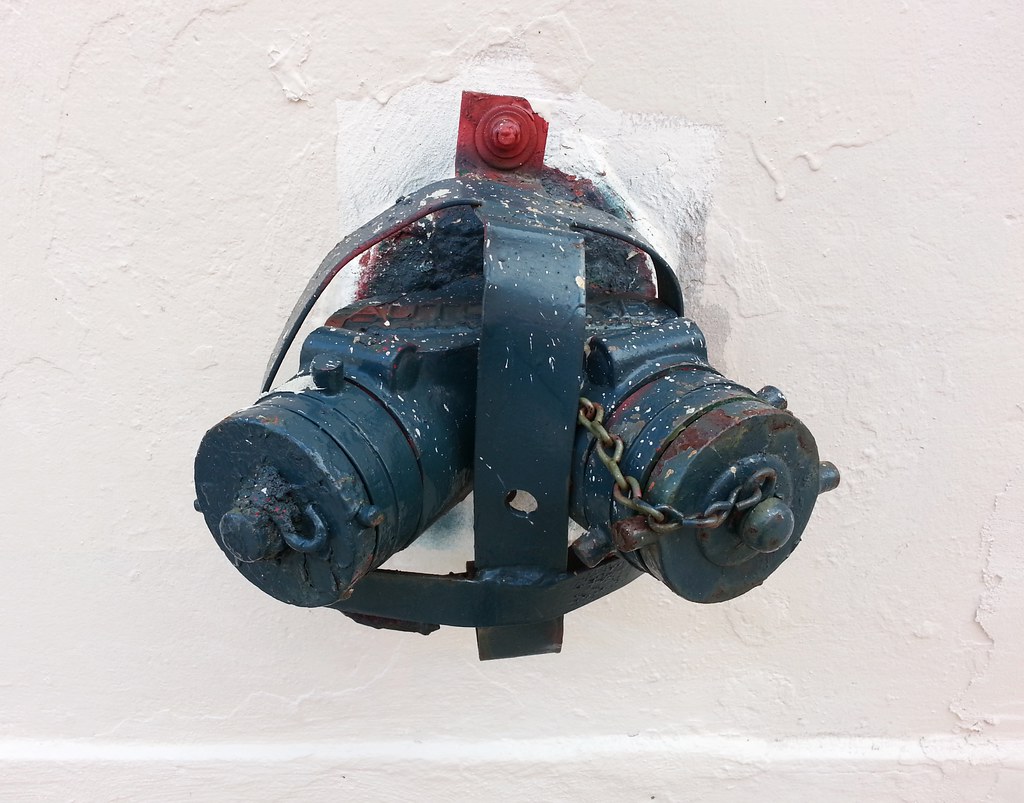
It's not one of the more vicious anti-butt devices I've seen, but at least it's trying harder than this one.

The former St. Paul's Evangelical Reformed Church
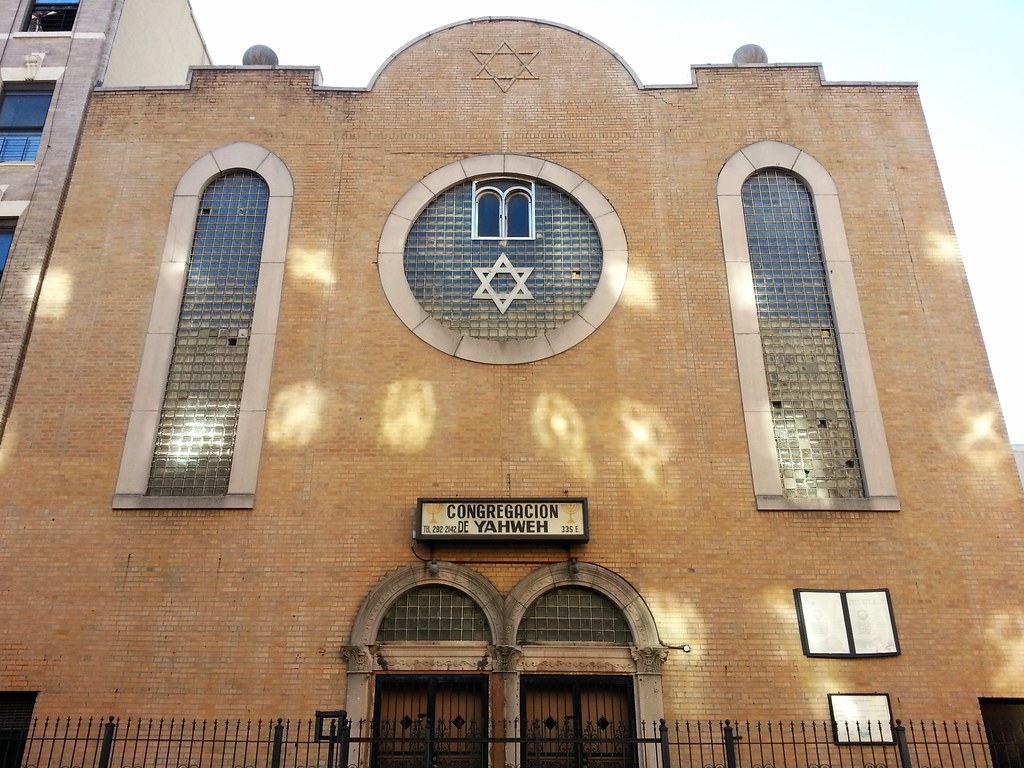
This is the former Chevra Shomrey Sabath, so we've got the "agogue" part covered. But the building's current occupant, Congregacion de Yahweh, is a Messianic Jewish congregation. As such, its members believe that Jesus was the messiah, but I don't think they would refer to themselves as a "church".

Sharing space with a recording studio and a boxing gym

We got a closer look last time.
(You can see the buildings from the previous photo reflected in the door of the SUV.)
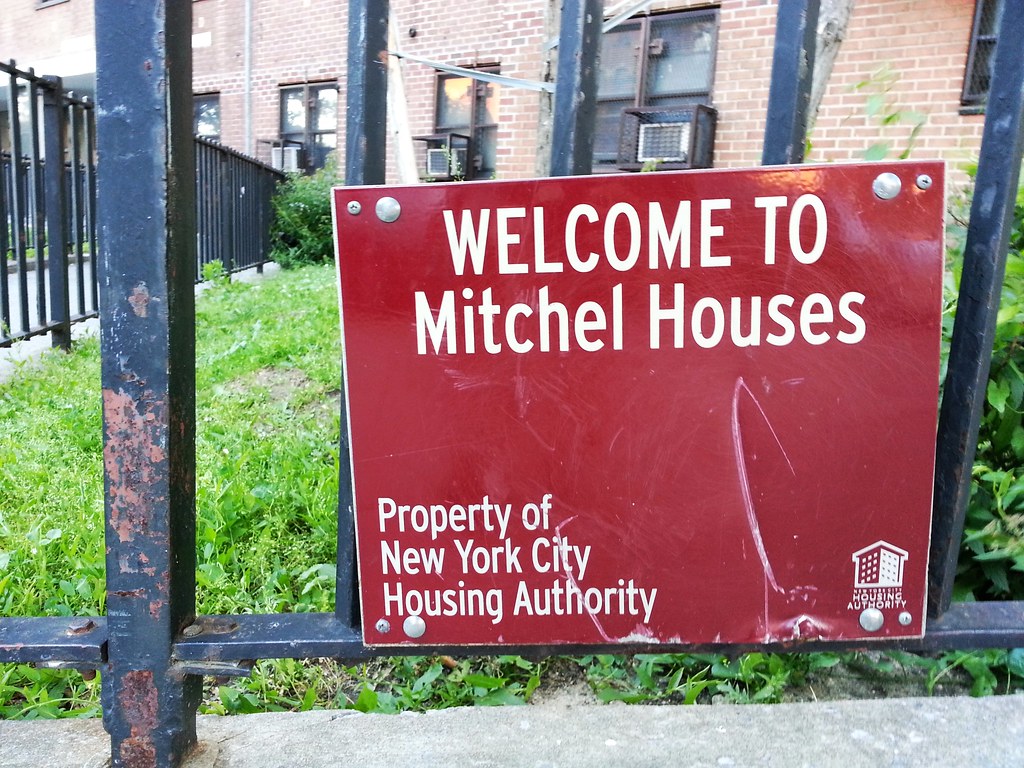
This public housing development is named for John Purroy Mitchel, the mayor of New York City from 1914 to 1917. Known as the "boy mayor", he was sworn in at the tender age of 34, making him the second-youngest mayor in the city's history, and the youngest to preside over the modern five-borough city.
An anti-Tammany reformer, Mitchel is widely considered to have been an effective and honest mayor. He was greatly admired by Fiorello La Guardia (the only NYC mayor to rank ahead of him in a "classic" 1960 study), whose mayoral speeches "rang with Mitchel's name". Teddy Roosevelt was also a big fan. Endorsing Mitchel's bid for re-election in 1917, Roosevelt wrote that Mitchel had "given us as nearly an ideal administration of the New York City government as I have seen in my lifetime, or as I have heard of since New York became a big city."
But despite his popularity among reform-minded, good-government types, Mitchel lost the 1917 race in a historic landslide. He may have been a good mayor, but he was a crummy politician — and he knew it. In fact, he had to be talked into running for a second term, as he believed, correctly as it turned out, that he would be unable to win. According to his secretary:
He knew just enough about politics to know that, unless an officeholder strives to please groups and factions to the sacrifice of real efficiency, re-election is impossible. Many times, in going over stacks of invitations, which came to him daily, I would urge him to go to this or that function, which was uninteresting and dull, but at which his attendance would please some group or section of the city. . . . He would absolutely refuse to attend these affairs, and when I would insist out of consideration for the fact that he was making political friends, he invariably replied that he had no desire to gain ground politically, that he was through with political life after this term, and that he merely wished to do the immediate job that lay before him the best he could.Shortly after leaving office, at the age of 38 and with World War I raging, Mitchel joined the Army's aviation service. The former boy mayor thus became "America's oldest flying cadet". But just a few months later, during a training exercise in Louisiana in 1918, he fell out of his plane and plummeted 500 feet to the ground, dying on impact. He had not been wearing his safety belt.
During his time in office, Mitchel carried a handgun, and once "brandished it in front of City Hall when he was fired upon by a crazed 71-year-old man". If the idea of a pistol-packing mayor sounds strange, keep in mind that Mitchel's predecessor, William Jay Gaynor, was himself the target of an assassination attempt, getting shot in the neck by a disgruntled former city employee.
Mitchel's record as a gun owner was somewhat tarnished, however, by another incident during his mayoralty. While he was exiting his car after a day of target practice upstate, a pistol he was carrying slipped out of its holster and fell to the sidewalk. The impact broke the safety, and the gun fired into the thigh of Mitchel's shooting partner, the real estate developer and former state senator William H. Reynolds.
So perhaps it is appropriate that a policeman stopped me outside of Mitchel's namesake housing project to question me about a suspicious-looking bulge in my back pocket. He and another officer who had previously seen me thought I might be carrying a gun. Turns out it was a water bottle.
And the gun-bottle distinction wasn't the only difference in our perceptions of reality:
Officer: You live around here?Now, I don't go around sticking my camera in people's faces, but I have walked through dozens of housing projects, and none of "these people" have yet kicked my ass or even threatened to do so. It's almost like if you walk around and act respectfully toward other people, they won't mess with you. Crazy!
Me: No, I don't.
Officer: Whatcha doin' here?
Me: Oh, I'm doing this big project, trying to walk every block of every street in the whole city.
Officer: OK, when you say that to me, I understand what you're saying. But these people [referring to the public housing residents], they're not gonna understand that. They see you walking around and taking pictures of them, they're gonna kick your ass. I've seen it happen. That's why I thought you might be carrying something to protect yourself.

Unlike those party poopers we saw earlier today, this combination doorstop and sprinkler connection would apparently be happy to play host to your big fat bottom. Look familiar?

Weed & Seed, Weed and Seed, Weed & Seed, Weed & Seed
(Close-up here)

Unlike its counterpart over at Captain Tilly Park, the plaque embedded in this monument appears to be a genuine Keck, cast from metal salvaged from the USS Maine.

This block-long Bronx thoroughfare is named for the old Mott Haven Canal, which once ran just east of here, along the route of today's Canal Place, from the Harlem River up to what is now 144th Street. (Here's a map of the canal, circa 1880.)
The neighborhood of Mott Haven was developed by Jordan L. Mott, the inventor of the coal-burning stove. Mott was the "first major industrialist to locate in the Bronx", establishing an ironworks on a large piece of land he purchased from Gouverneur Morris II (who, in his later years, was "guided into church every Sunday morning by his women folks, his hair and cravat awry, and possessed of a great bandanna handkerchief, with which, from time to time, he blew sonorous blasts through his nose that set the young folk off into convulsive giggles.")
According to the Landmarks Preservation Commission:
Though some considered his ventures an unwanted intrusion, in 1850 Mott proceeded with plans for the lower part of the Mott Haven Canal, which followed an underground stream running parallel to Morris Avenue, about halfway between it and the Harlem River. The canal enabled boats to travel inland as far north as 138th Street, about the distance of a dozen blocks, and encouraged local industrial development. New enterprises included other metal works, lumber yards, saw mills, stone yards, enamel works and a notable concentration of impressively-built piano factories.A proposal was later made to extend the canal up to Main Street (today's 144th Street), as told by Stephen Jenkins in his 1912 history of the Bronx:
In 1869, the property passed into the hands of Rider and Conkling, the owners of about six hundred lots in Mott Haven, who proposed to complete the canal to Main Street; but they at once met with opposition from the residents and landowners of the vicinity, on the ground of the liability of the canal's becoming a source of malaria and a nuisance.Rider and Conkling won approval for the extension by promising to dredge the canal and build bulkhead walls along it, construct and maintain bridges over it, and fill it in at their own expense should it ever be deemed a public nuisance. However:
The owners failed to bulkhead the canal as agreed, and the mud banks frequently caved in. Locks were constructed, which prevented the rise and fall of the tide; so that the canal became an actual cesspool in which the bodies of dead animals and other refuse floated for days. The canal was declared a public nuisance by the boards of health of both Morrisania and New York; and, after annexation, by the Park Department, by the Department of Street Improvements, by the Board of Estimate, and by other public bodies.That sounds like an open-and-shut case for filling the canal. But, as reported by the NY Times in 1900:
For years the citizens and property owners of the neighborhood have been fighting to have the "canal" filled in, claiming that it was a public nuisance, a breeder of disease, and a depreciator of property values for blocks around in all directions. The alleged nuisance was fought before the Park Board, the Department of Street Improvements, Board of Health, Board of Street Openings, local board, and Board of Public Improvements, in turn, and while each of these sustained the citizens in their fight, yet, so strong has been the influence wielded by the North River Electric Light and Power Works, whose power house is on the canal, that the actual filling has been successfully staved off each time.The residents of Mott Haven finally had their way, however, and the portion of the canal north of 138th Street was filled in and made over as Canal Place by the end of 1903, with the original section south of 138th Street being likewise filled in some years later. So, while this controversial waterway has long since vanished from the map, it is, like its much more famous Manhattan counterpart, still recalled by the aluminum street signs that mark its former course, proclaiming with earnest enthusiasm to all who wander past: CANAL!
The company, it is said, effects a considerable saving in running expenses by the use of the water for condensing purposes and for towing coal to the works. Interested in it as stockholders are said to be some of the most powerful Tammany politicians, and it is alleged that so strong has been this influence that there has never been wanting a city official ready and willing to block its progress on technicalities, postponements of action, &c., so that it has come to be believed in the neighborhood that Richard Croker himself is a stockholder.
(On a side note, the Mott Haven Canal, seen here, was, despite its sullied reputation, the inspiration for at least two works of art that have stuck around long enough to be uploaded to the internet. You can view them here and here.)





